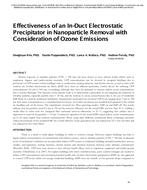Description
Human exposure to ultrafine particles (UFP, less than 100 nm) has been shown to have adverse health effects such asrespiratory impacts and cardiovascular mortality. UFP concentrations can be elevated in occupied buildings due toprevalence of UFP sources within buildings such as combustion, heating elements, and electric motors, as well as entry withoutdoor air. In-duct electrostatic air filters (ESP) have been an efficient particulate control device for reducing UFPconcentrations (10 nm to 100 nm) in buildings, although they have the potential to increase indoor ozone concentrationsdue to corona discharge. The objective of the present study is to demonstrate a procedure for investigating the reduction ofultrafine particles, especially particle sizes less than 10 nm, and the increase in ozone concentrations due to the use of residentialESP filters in a realistic residential installation. Experiments monitored size-resolved UFP levels ranging from 3 nm to 100nm and ozone concentrations in a manufactured test house. An in-duct air cleaner was installed and operated in the centralair handling unit of the house. The experiments involved two filter operating modes: ESP on and ESP off. The resultsindicate that for particles sized 8.2 nm to 9.8 nm the removal efficiency for the tested ESPs was less than 10 %. Adding amedia filter in series with the energized filter increased removal efficiencies to 25 %, suggesting that surface area isimportant to removal for particles < 10 nm. Continuous operation of the tested ESPs raised indoor ozone concentrationsup to six times higher than outdoor concentrations. When using three different commercial filters containing activatedcarbondownstream of the installed ESP, the overall effective ozone generation rate was reduced by 25 % for one filter andnot reduced by two other filters.
Citation: IAQ Conference: IAQ 2013: Environmental Health in Low Energy Buildings
Product Details
- Published:
- 2013
- Number of Pages:
- 8
- File Size:
- 1 file , 1.1 MB
- Product Code(s):
- D-2013IAQConf-07




